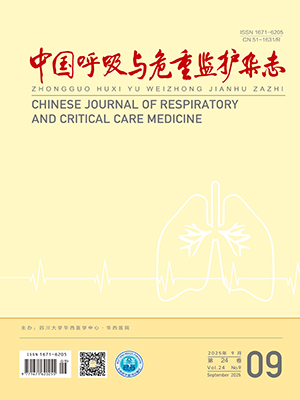| 1. |
Kohno N, Akiyama M, Kyoizumi S, et al. Detection of soluble tumor-associated antigens in sera and effusions using novel monoclonal antibodies, KL-3 and KL-6, against lung adenocarcinoma. Jpn J Clin Oncol, 1988, 18(3): 203-216.
|
| 2. |
Ohtsuki Y, Fujita J, Hachisuka Y, et al. Immunohistochemical and immunoelectron microscopic studies of the localization of KL-6 and epithelial membrane antigen (EMA) in presumably normal pulmonary tissue and in interstitial pneumonia. Med Mol Morphol, 2007, 40(4): 198-202.
|
| 3. |
Ishikawa N, Hattori N, Yokoyama A, et al. Utility of KL-6/MUC1 in the clinical management of interstitial lung diseases. Respir Investig, 2012, 50(1): 3-13.
|
| 4. |
Hu Y, Wang LS, Jin YP, et al. Serum Krebs von den Lungen-6 level as a diagnostic biomarker for interstitial lung disease in Chinese patients. Clin Respir J, 2017, 11(3): 337-345.
|
| 5. |
Ohshimo S, Ishikawa N, Horimasu Y, et al. Baseline KL-6 predicts increased risk for acute exacerbation of idiopathic pulmonary fibrosis. Respir Med, 2014, 108(7): 1031-1039.
|
| 6. |
Travis WD, Costabel U, Hansell DM, et al. An official American Thoracic Society/European Respiratory Society statement: Update of the international multidisciplinary classification of the idiopathic interstitial pneumonias. Am J Respir Crit Care Med, 2013, 188(6): 733-748.
|
| 7. |
American Thoracic Society. Idiopathic pulmonary fibrosis: diagnosis and treatment. International consensus statement. American Thoracic Society (ATS), and the European Respiratory Society (ERS). Am J Respir Crit Care Med, 2000, 161(2 Pt 1): 646-664.
|
| 8. |
Collard HR, Ryerson CJ, Corte TJ, et al. Acute Exacerbation of Idiopathic Pulmonary Fibrosis: An International Working Group Report. Am J Respir Crit Care Med, 2016, 194(3): 265-275.
|
| 9. |
Rangu G, Collard HR, Egan JJ, et al. An Official ATS/ERS/JRS/ALAT Statement: Idiopathic Pulmonary Fibrosis: Evidence-based Guidelines for Diagnosis and Management. Am J Respir Crit Care Med, 2011, 183(6): 788-824.
|
| 10. |
Shiboski SC, Shiboski CH, Criswell L, et al. American College of Rheumatology Classification Criteria for Sjögren’s syndrome: A Data-driven, Expert Consensus Approach in the Sjögren’s International Collaborative Clinical Alliance Cohort. Arthritis Care Res (Hoboken), 2012, 64(4): 475-487.
|
| 11. |
Aletaha D, Neogi T, Silman AJ, et al. 2010 Rheumatoid Arthritis Classification Criteria: An American College of Rheumatology/European League Against Rheumatism Collaborative Initiative. Arthritis Rheum, 2010, 62(9): 2569-2581.
|
| 12. |
Jennette JC, Falk RJ, Bacon PA, et al. 2012 Revised International Chapel Hill Consensus Conference Nomenclature of Vasculitides. Arthritis Rheum, 2013, 65(1): 1-11.
|
| 13. |
Mosca M, Tani C, Bombardieri S. Undifferentiated connective tissue diseases (UCTD): a new frontier for rheumatology. Best Pract Res Clin Rheumatol, 2007, 21(6): 1011-1023.
|
| 14. |
van den Hoogen F, Khanna D, Fransen J, et al. 2013 Classification Criteria for Systemic Sclerosis: An American College of Rheumatology/European League against Rheumatism Collaborative Initiative. Ann Rheum Dis, 2013, 72(11): 1747-1755.
|
| 15. |
Fathi M, Barbasso HS, Lundberg IE. KL-6: a serological biomarker for interstitial lung disease in patients with polymyositis and dermatomyositis. J Intern Med, 2012, 271(6): 589-597.
|
| 16. |
Lee YS, Kim HC, Lee BY, et al. The value of biomarkers as predictors of outcome in patients with rheumatoid arthritis-associated usual interstitial pneumonia. Sarcoidosis Vasc Diffuse Lung Dis, 2016, 33(3): 216-223.
|
| 17. |
Kumánovics G, Görbe E, Minier T, et al. Follow-up of serum KL-6 lung fibrosis biomarker levels in 173 patients with systemic sclerosis. Clin Exp Rheumatol, 2014, 32(6 Suppl 86): 138-144.
|
| 18. |
Oguz EO, Kucuksahin O, Turgay M, et al. Association of serum KL-6 levels with interstitial lung disease in patients with connective tissue disease: a cross-sectional study. Clin Rheumatol, 2016, 35(3): 663-666.
|
| 19. |
Benyamine A, Heim X, Resseguier N, et al. Elevated serum Krebs von den Lungen-6 in systemic sclerosis: a marker of lung fibrosis and severity of the disease. Rheumatol Int, 2018, 38(5): 813-819.
|
| 20. |
Xu L, Yan DR, Zhu SL, et al. KL-6 regulated the expression of HGF, collagen and myofibroblast differentiation. Eur Rev Med Pharmacol Sci, 2013, 17(22): 3073-3077.
|
| 21. |
Nukiwa T. The role of biomarkers in management of interstitial lung disease: implication of biomarkers derived from type II pneumocytes. Eur Respir Mon, 2009, 46: 47-66.
|
| 22. |
Jun S, Park B, Seo JB, et al. Development of a computer-aided differential diagnosis system to distinguish between usual interstitial pneumonia and non-specific interstitial pneumonia using texture- and shape-based hierarchical classifiers on HRCT images. J Digit Imaging, 2018, 31(2): 235-244.
|
| 23. |
Ohnishi H, Yokoyama A, Kondo K, et al. Comparative study of KL-6, surfactant protein-A, surfactant protein-D, and monocyte chemoattractant protein-1 as serum markers for interstitial lung diseases. Am J Respir Crit Care Med, 2002, 165(3): 378-381.
|
| 24. |
Takahashi H, Kuroki Y, Tanaka H, et al. Serum levels of surfactant proteins A and D are useful biomarkers for interstitial lung disease in patients with progressive systemic sclerosis. Am J Respir Crit Care Med, 2000, 162(1): 258-263.
|
| 25. |
Kakugawa T, Yokota S, Ishimatsu Y, et al. Serum heat shock protein 47 levels are elevated in acute exacerbation of idiopathic pulmonary fibrosis. Cell Stress Chaperones, 2013, 18(5): 581-590.
|
| 26. |
Cao MS, Swigris JJ, Wang X, et al. Plasma leptin is elevated in acute exacerbation of idiopathic pulmonary fibrosis. Mediators Inflamm, 2016: 6940480.
|
| 27. |
Qiu M, Chen Y, Ye Q. Risk factors for acute exacerbation of idiopathic pulmonary fibrosis: a systematic review and meta-analysis. Clin Respir J, 2018, 12(3): 1084-1092.
|
| 28. |
Collard HR, Moore BB, Flaherty KR, et al. Acute exacerbations of idiopathic pulmonary fbrosis. Am J Respir Crit Care Med, 2007, 176(7): 636-643.
|
| 29. |
任登华, 丁晶晶, 蔡后荣, 等. 血清 KL-6 水平在间质性肺疾病诊断中的价值研究. 中国呼吸与危重监护杂志, 2015, 14(5): 468-473.
|




